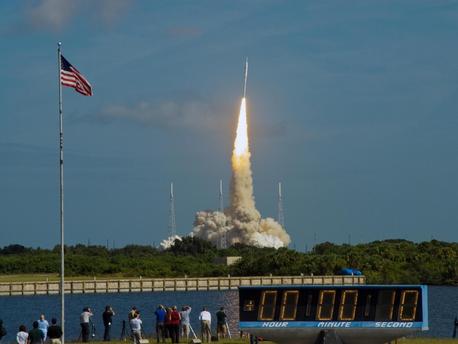New Powerful Rocket
Ares I-X Completes a Successful Flight Test
 © NASA/Jim Grossmann
|
The stars and stripes on the American flag reflect NASA's commitment to teamwork as the Constellation Program's Ares I-X test rocket roars off Launch Complex 39B at NASA's Kennedy Space Center in Florida.
Parachutes deployed for recovery of the booster and the solid rocket motor, which were recovered at sea and will be towed back to Florida by the booster recovery ship, Freedom Star, for later inspection. The simulated upper stage and Orion crew module, and the launch abort system will not be recovered.
The flight test is expected to provide NASA with an enormous amount of data that will be used to improve the design and safety of the next generation of American spaceflight vehicles, which could again take humans beyond low Earth orbit.
Credit: NASA
New Powerful Rocket
Ares I-X Completes a Successful Flight Test
 © NASA/Jim Grossmann
|
The stars and stripes on the American flag reflect NASA's commitment to teamwork as the Constellation Program's Ares I-X test rocket roars off Launch Complex 39B at NASA's Kennedy Space Center in Florida.
Parachutes deployed for recovery of the booster and the solid rocket motor, which were recovered at sea and will be towed back to Florida by the booster recovery ship, Freedom Star, for later inspection. The simulated upper stage and Orion crew module, and the launch abort system will not be recovered.
The flight test is expected to provide NASA with an enormous amount of data that will be used to improve the design and safety of the next generation of American spaceflight vehicles, which could again take humans beyond low Earth orbit.
Credit: NASA






